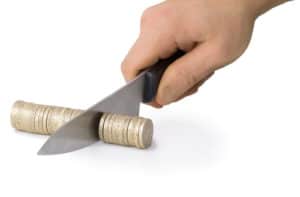

If you’re going to bet on sports, you need to understand the odds before you put any cash down. There’s no way for you to know the risk involved in your particular wager or the potential payoff unless you know how betting odds work. If you’re looking for the best odds at an online sportsbook, be sure you check out Bovada.
 It’s essential to understand that odds are a determination of how a specific event may play out. They are not saying that the event will end in the manner predicted. They predict the likelihood of an outcome.
It’s essential to understand that odds are a determination of how a specific event may play out. They are not saying that the event will end in the manner predicted. They predict the likelihood of an outcome.
Those wagering on the favored team usually do so at a disadvantage, while those wagering on the underdog are given an edge. Sportsbooks do this in an attempt to even out the bets so that there’s an equal amount of cash placed on each team.
When wagering, you’ll find that there are three basic ways that odds are listed:
To convert decimal odds to fractional, subtract 1.00 and then find the nearest whole integers (so 3.75 - 1.00 becomes 2.75/1, or 11/4).
To convert moneyline odds to decimal, if the moneyline is positive, divide by 100 and add 1. If it is negative, divide 100 by the moneyline amount (without the minus sign) and add 1.
To convert fractional odds to decimal, divide the first figure by the second figure add 1.00 (so 11/4 = 2.75, then add 1.00 = 3.75).
| UK | EU | US |
|---|---|---|
| 1/5 | 1.20 | -500 |
| 2/9 | 1.22 | -450 |
| 1/4 | 1.25 | -400 |
| 2/7 | 1.28 | -350 |
| 3/10 | 1.30 | -333.30 |
| 1/3 | 1.33 | -300 |
| 7/20 | 1.35 | -285.70 |
| 4/11 | 1.36 | -275 |
| 2/5 | 1.40 | -250 |
| 4/9 | 1.44 | -225 |
| 9/20 | 1.45 | -222.20 |
| 40/85 | 1.47 | -212.50 |
| 1/2 | 1.50 | -200 |
| 8/15 | 1.53 | -187.50 |
| 4/7 | 1.57 | -175 |
| 3/5 | 1.60 | -166.70 |
| 8/13 | 1.62 | -162.50 |
| 5/8 | 1.63 | -160 |
| 4/6 | 1.66 | -150 |
| 7/10 | 1.70 | -142.90 |
| 8/11 | 1.72 | -137.50 |
| 4/5 | 1.80 | -125 |
| 5/6 | 1.83 | -120 |
| 9/10 | 1.90 | -111.10 |
| UK | EU | US |
|---|---|---|
| 10/11 | 1.91 | -110 |
| 20/21 | 1.95 | -105 |
| 1/1 | 2.00 | -100 |
| 21/20 | 2.05 | +105 |
| 11/10 | 2.10 | +110 |
| 6/5 | 2.20 | +120 |
| 5/4 | 2.25 | +125 |
| 13/10 | 2.30 | +130 |
| 11/8 | 2.38 | +137.50 |
| 7/5 | 2.40 | +140 |
| 6/4 | 2.50 | +150 |
| 8/5 | 2.60 | +160 |
| 13/8 | 2.63 | +162.50 |
| 17/10 | 2.70 | +170 |
| 7/4 | 2.75 | +175 |
| 9/5 | 2.80 | +180 |
| 15/8 | 2.88 | +187.50 |
| 19/10 | 2.90 | +190 |
| 2/1 | 3.00 | +200 |
| 21/10 | 3.10 | +210 |
| 85/40 | 3.13 | +210 |
| 11/5 | 3.20 | +220 |
| 9/4 | 3.25 | +225 |
| 23/10 | 3.30 | +230 |
| UK | EU | US |
|---|---|---|
| 95/40 | 3.38 | +237.50 |
| 12/5 | 3.40 | +240 |
| 5/2 | 3.50 | +250 |
| 13/5 | 3.60 | +260 |
| 11/4 | 3.75 | +275 |
| 14/5 | 3.80 | +280 |
| 3/1 | 4.00 | +300 |
| 16/5 | 4.20 | +320 |
| 10/3 | 4.33 | +333.30 |
| 7/2 | 4.50 | +350 |
| 18/5 | 4.60 | +360 |
| 4/1 | 5.00 | +400 |
| 9/2 | 5.50 | +450 |
| 5/1 | 6.00 | +500 |
| 11/2 | 6.50 | +550 |
| 6/1 | 7.00 | +600 |
| 13/2 | 7.50 | +650 |
| 7/1 | 8.00 | +700 |
| 15/2 | 8.50 | +750 |
| 8/1 | 9.00 | +800 |
| 17/2 | 9.50 | +850 |
| 9/1 | 10.00 | +900 |
| 10/1 | 11.00 | +1000 |
| 50/1 | 51.00 | +5000 |
Also known as Tradional or British
Also known as European
Also known as American
U.S. odds are reflected in the moneyline or line. They’re expressed in whole numbers with the number for the favored team showing a minus and the number for the team that is not favored having a plus in front of it.
Here is a moneyline for football:
 This betting line favors the Colts. Indy is listed at 2:1. That means for every $2.00 bet the payout would be $3.00. That includes the $2.00 you wagered plus a profit of $1.00. If you take the Bears, the odds would be 1:4. On a $1.00 bet Chicago, which is the underdog, would pay a total of $5.00. That includes the $1.00 bet and the $4.00 payout.
This betting line favors the Colts. Indy is listed at 2:1. That means for every $2.00 bet the payout would be $3.00. That includes the $2.00 you wagered plus a profit of $1.00. If you take the Bears, the odds would be 1:4. On a $1.00 bet Chicago, which is the underdog, would pay a total of $5.00. That includes the $1.00 bet and the $4.00 payout.
The bettor always gets a bigger payout when they assume a greater risk. The more the risk, which would reflect the unlikely chance of something happening, the more you profit if the bet is won. Consider that a team that’s listed at -200 has a 66.66% chance of winning, while a team at +400 has a 20% chance of victory.
 Fractional odds, which are also known as English odds, are a bit easier to understand. If the same NFL game were listed using the fractional system it would look like this:
Fractional odds, which are also known as English odds, are a bit easier to understand. If the same NFL game were listed using the fractional system it would look like this:
With this type of listing, the first number in the fraction, the numerator, is the amount you would wager and the second number, the denominator, is the payout amount. The payouts and risk in this example are exactly the same as that in the American example, with the Colts paying a $1.00 profit for every $2.00 bet and the Bears offering a $4.00 profit for every $1.00 wagered.
 You’ll find decimal odds used most often in Europe and for this reason they are known as European odds. These may be the most confusing to American bettors because the math is hidden.
You’ll find decimal odds used most often in Europe and for this reason they are known as European odds. These may be the most confusing to American bettors because the math is hidden.
Once again using the same example from the NFL, the decimal odds would be displayed in this manner:
In this system, the smaller the number the less risk involved and the better the chances are that a team will be victorious. To understand how much you will win, you would multiply the amount wagered by the betting line.
In this example, on a $1.00 bet on Chicago you would get back a total of $5.00 and on a $2.00 bet on the colts, you’d realize $3.00. As you can see, regardless of the format of the betting lines, the payout is the same.
Betting odds can be given in various ways. The important thing to understand is they’re not “real.” They are skewed to ensure that the sportsbooks make a profit.
Built into the odds is the sportsbook’s commission, which is silently collected on every bet. In real life, the Colts probably have less of a chance of winning and should pay more while the Bears are even more likely to lose than the odds reflect and should also pay more.
Those are the basics to understanding odds. If you’re an American bettor, then chances are you’ll be using the U.S. version. Europe or other parts of the world, you’re going to encounter the two other types of listings.
 There are a few important aspects of sports betting payouts that you must understand in order to ensure that you’re able to take full advantage of wagering opportunities and to successfully manage your bankroll.
There are a few important aspects of sports betting payouts that you must understand in order to ensure that you’re able to take full advantage of wagering opportunities and to successfully manage your bankroll.
First we’ll take a look at some basic odds and related payouts and then we’ll consider some of the finer aspects of the payout.
You must be able to read the odds listed in order to understand how much you will make on a bet. The amount of cash that you make, your profit, is your payout. Some sports bets, such as those involving a point spread, usually pay approximate odds of 1:1. That means for every dollar wagered, you’re going to get that dollar plus another buck if you win your wager.
Here’s a look at the three ways of expressing odds that you’ll usually find listed for a favorite.
| Moneyline (American) | Fraction (English) | Decimal (European) |
| -200 | 1/2 | 1.50 |
Each of these expressions of odds represents the same wager and payout. For every $2.00 bet, you win a dollar, making the total amount of cash you get back $3.00 ($2.00 bet + $1.00 payout = $3.00 return).
These are an example of the type of odds given for a team that’s not favored.
| Moneyline (American) | Fraction (English) | Decimal (European) |
| +200 | 2/1 | 3.00 |
These odds tell you that for every $1.00 you bet, you’re going to get $2.00 back. The payout on this sports bet is $2.00 ($1.00 bet + $2.00 payout = $3.00 return)
Notice that you get the same amount of cash back on both bets but that you actually make double on the second wager. Never confuse “return,” which is the total amount of cash you get back when you win, with “payout,” which is actually how much you make. When it comes to sports betting you’re biggest concern is how big the payout is in relationship to how much you wagered.
 One element that many new bettors are not aware of is the commission that is paid by gamblers to bookies or sportsbooks. The commission is often referred to as vig, vigorish or juice.
One element that many new bettors are not aware of is the commission that is paid by gamblers to bookies or sportsbooks. The commission is often referred to as vig, vigorish or juice.
This part of sports betting is important because it alters your payout, lessening it. Here’s the way it works. Vig can be readily seen in point spread betting and when you bet on the favorite using the moneyline.
Although the spread odds expressed in sports betting are 1/1, they are really approximately 1/1.10.
Here’s why:
When you place a $1.00 point spread wager, you place the dollar bet plus 10%. Thus, you would place $1.10 on a team to win $1.00. You get back your original bet, $1.10, and the one-dollar payout. But if this were a true 1/1 wager, your payout would be $1.10. What happens to the 10 cents? That’s the sportsbook’s commission.
The same can be seen with the -110 moneyline. In order to win $100 on that moneyline, you must put up $110. The way bookies make their commission on the moneyline is they charge more than they should to bet on the favorite and undercut the payout on the underdog. Thus, the vig is often hidden, but it is there.
It’s important that you learn how to manage your sports betting bankroll and that means keeping track of all wagers, loses and payout. When looking at a potential payout always consider the risk involved in the bet and what percentage of your bankroll you’re willing to commit to that bet. Never risk more than 5% of your bankroll on a bet.
Understanding the payout in relationship to the amount of money risked and the total return is important to be able to manage your bankroll and sports betting business.
 When is it too late to make a bet? When the game is over. But the more complex answer has to do with how much you have to wager, what your objective is and how much you’ve lost or won.
When is it too late to make a bet? When the game is over. But the more complex answer has to do with how much you have to wager, what your objective is and how much you’ve lost or won.
Here are some guidelines that will help you decide when you should wager on props when the odds are becoming more favorable, diminishing odds, and when you should bet on propositions whose odds are going up or expanding:
There are various times when you should play props whose odds are going from being long shots to sure shots. With a diminishing odds bet, the chance of the prop being a winner is becoming more certain. Bets in this category range from 2-1 to 1-4.
Play these in the following situations:
The above situations are all designed to make sure that you limit your loses. Along with wagering on bets that offer you low odds, make sure you bet on props about which you feel confident. The point is to give yourself the best chance of winning.
As odds expand and go higher so do the payouts. Although commonsense tells you that these wagers are getting progressively more difficult to win, there are times that you should utilize them.
Betting on these scenarios isn’t as foolhardy as you might think since you are limiting how much you’re going to wager, lessening your loses. Stay away from tossing a lot of cash on a bet that has expanding betting lines. If you don’t, you may see your cash diminish quickly.
The thing to remember about live sports betting is that as the game goes on and things change, the odds will also change. As they do, you can take advantage of them in various ways. Also, be careful not to bet too much.